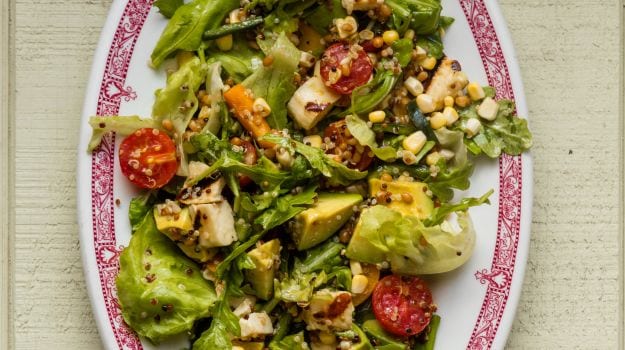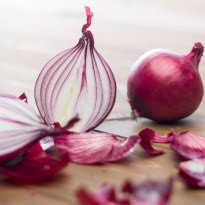 There was a time when the word “salad” referred to little more than a pile of iceberg lettuce. It was ornamentation, sometimes doused in a sickly-sweet, carrot-colored dressing described, inexplicably, as “French.”
There was a time when the word “salad” referred to little more than a pile of iceberg lettuce. It was ornamentation, sometimes doused in a sickly-sweet, carrot-colored dressing described, inexplicably, as “French.”
No one then may have actually wanted to eat a salad. It was punishment, a self-flagellation for all the truly delicious things we had been eating, for the jiggle we were slowly accruing. If you threw in a couple of cherry tomatoes and a few croutons so stale they resembled moon rocks, you could tote one of those travesties to a summer potluck, and people would practically thank you for bringing something healthful.
Then, something happened. A trend that traces right back to the produce aisles and to the boom in farmers markets, places where vegetables such as sweet potatoes, mache, turnip greens and ramps have turned up anew.
We have more ingredients within our reach. We also have more notions about how we might prepare them: Should we grill or spiralize? Go raw or serve our vegetables slightly warm?
Amid all that change, the pallid pile of lettuce and bacon bits went out. Complexity is in. And a modern salad can require as much thinking – and, occasionally, cooking – as an elaborate main course. These days, it often is the main course. If your salad making skills haven’t quite kept pace, one could hardly blame you.
“When you have all these ingredients, that’s the hard part,” says Michael Stebner, culinary director for the salad chain Sweetgreen, which dishes up bowls with as many as eight components, some of them as labor-intensive as spicy, blackened broccoli or baked falafel. We all wonder, he says, “How am I going to compose a salad that isn’t confusing?”
Here’s how: Follow these tips from Stebner for upping your salad game.
Pluck one or two in-season vegetables to be your salad’s stars.
Homing in on a few main flavors will help keep even an elaborate salad grounded. Let the season dictate what those flavors should be.
“Don’t go to the market expecting to find something, and, if you don’t find it, your plans are ruined,” says Stebner. Choose what’s sprouting up all over the markets you frequent. At the height of summer, it might be sweet corn and tomatoes, which Stebner picked to demonstrate how to compose a summer salad. Whatever you choose, however, it will taste better when it’s in season.
More about seasonality: When the market is spilling over with vegetables at the height of summer, fight the urge to turn on the oven and, say, roast sweet potatoes. “This time of year, for me, it’s about not cooking,” Stebner says. If you’re using in-season vegetables, they will be at their ripest and sweetest, and you can absolutely eat them raw, with a hint of seasoning. “The ingredients do all the work,” Stebner says. (Worthy exception: making use of the grill and your stockpile of briquettes to blacken corn, chilies or, if you’re feeling really rock-and-roll, romaine lettuce.)
Once the weather turns and you’re staring down piles of cauliflower, potatoes and Brussels sprouts, by all means, turn on the oven and roast them, and season heavily. “In the winter,” Stebner says, “you’re going for deeper, more rich flavors.”
You’re going to need some inspiration.
You’ve arrived at the most confounding moment in salad making: What do you add now?
Having a game plan helps, and how you arrive at it varies. Maybe you want to tweak a Caesar salad, or channel the flavors of shawarma. Or you can let the market guide you. Stebner likes to heed the old farming proverb “what grows together, goes together”; it’s why he chose to pair corn with tomatoes, because both reach their peak at roughly the same time of year. It also explains why, in the chillier months, crunchy beets pair so perfectly with winter citrus such as grapefruit and blood orange.
You can also look for cultural inspiration in the ingredients you have on hand. Stebner kicked around a faintly Italian theme that would pair his market finds with basil and a burrata or mozzarella cheese. But then he grabbed a few sweet peppers and avocados, and his concept changed. He reached for chewy, mild halloumi cheese and then could see he had in hand exactly what he needed for a meatless dish with a tinge of Latin American influence: a marinated corn salad with peppers and avocado.
Layer in textures and flavors.
Now it’s time to pile in chewy and crunchy elements and herbs that will add spice, acid, sweetness or creaminess to your salad.
Proteins such as chicken and tofu can turn a side salad into an entree, but so can wheat berries, farro and quinoa, which pack protein, iron and a nutty flavor.
For a funkiness that complements bitter lettuces and sour vinegars, Stebner frequently turns to goat cheeses. “We’re looking for umami, we’re looking for richness. And cheese is going to give you that,” he says. But for his corn salad, he used halloumi, a mild, buttery Mediterranean cheese that becomes chewy when tossed into a grill pan. It adds a warm element to Stebner’s cool, mostly raw salad.
For creaminess, bypass ranch dressing and try wedges of ripe avocado. There are myriad ways to add something crunchy, too: Toast almonds or even tiny kernels of raw quinoa in a dry pan until they’re golden, and toss them in. Or throw in chia seeds, which won’t add flavor, Stebner says, but will pack a nutritional punch.
With the tomatoes, corn and peppers going into his salad raw – they’ll contribute that crunch – Stebner lightly marinated them, giving them an hour to soak in a bath of vinegar and oil. Another pro tip: He blended some smoked salt into his dressing to add a faint taste of the grill without having to sweat over real flames.
Stebner suggests using a few almost imperceptible sprigs of in-season herbs such as basil, mint, tarragon and parsley; they, too, can add zip to your greens.
Practice your knife skills. Because raw onion slices the size of the rings of Saturn have no place in your salad.
To make sure every bite has an ideal mix of flavors, cut or tear your ingredients so they’re about the same size, says Stebner. Thinly shave a radish to temper its punch. Dice that onion.
No thick, orange cubes of cheddar cheese, no enormous hunks of roasted Brussels sprouts, no cherry tomatoes tossed in whole. Bite-size cuts will play nicer together.
Kale is (somehow!) still trendy. But not every salad should be a kale salad.
“Lettuce is a main player in a salad,” says Stebner.
He suggests considering flavor and texture when deciding which greens will best complement your starring ingredients. Arugula is flavorful, all peppery bite. Mesclun, tender and neutral. Iceberg is earthy, if otherwise lacking in flavor, but it can provide crunch the others don’t.
If your main ingredient is sweet, as with Stebner’s corn salad, or if you’re making a peach or watermelon salad, arugula’s savory qualities can spice things up. In the raw corn salad, it adds “an herbal, peppery flavor that is going to go against the sweet, ripe flavor of the corn,” says Stebner. “It’s my favorite, because it has so much flavor and so much character.”
And when you’re working with stronger flavors, such as roasted vegetables, and mushier textures, reach for crunchy, mild greens such as gem lettuce and romaine.
Okay, nowthrow in a little kale. Or better, watercress, chard, or mustard or beet greens.
A salad isn’t an either-or equation. If you’re worried that your delicious salad is also shaping up to be a nutritionally vacuous one, slipping in a few healthful vegetables won’t turn it into a macrobiotic yoga meal only Gwyneth Paltrow could enjoy. Stebner advises mixing up your lettuces, cutting a crowd-pleasing spring mix with a few ragged leaves of kale. The easy-to-digest greens will help the healthful ones seem a little more palatable to your salad-averse friends, plus they can add texture to your salad: In Stebner’s corn salad, arugula brings flavor, but its leaves can quickly go limp. He adds butter lettuce, a sweet, crisp green, to amplify the volume and add bite.
Don’t pile on.
It’s a salad, not a three-ring circus. It’s entirely possible to have too many crunchy, salty and smoky elements doing back flips for any one player in your salad to make an impression. “Adding more ingredients doesn’t improve the flavor, and too many can make it muddy and confusing,” says Stebner.
Make your dressing at home.
Bottled dressings are convenient, but a basic homemade dressing takes only a whisk and a few ingredients probably already on your shelves. Stebner makes a pantry-friendly dressing by mincing garlic to release its flavor and blending it with sherry vinegar, smoked salt and olive oil. “Sherry vinegar is more nuanced,” says Stebner, preferable in the summer to the overused balsamic. In the fall, he suggests trying apple cider vinegar. (It will play nicely with a tart fall apple salad.) To help emulsify the dressing so the oil and vinegar are combined into one rich mix that won’t separate before you’re ready to toss it all together, he loves using an immersion (stick) blender.
Now, break out the tongs and toss. And keep at it till every leafy green appears coated.
Now is not the time to fret about calories or to defer to your aunt who asks for dressing on the side. Your salad is ready when every element is dressed. Says Stebner: “It doesn’t have to have a ton of dressing. If it’s mixed well, it does the work.”
[“source-timesofindia”]










